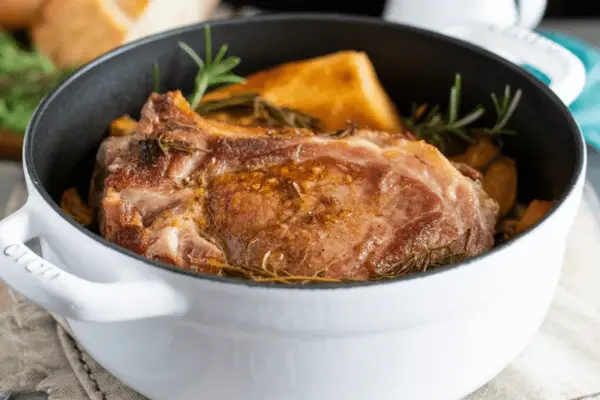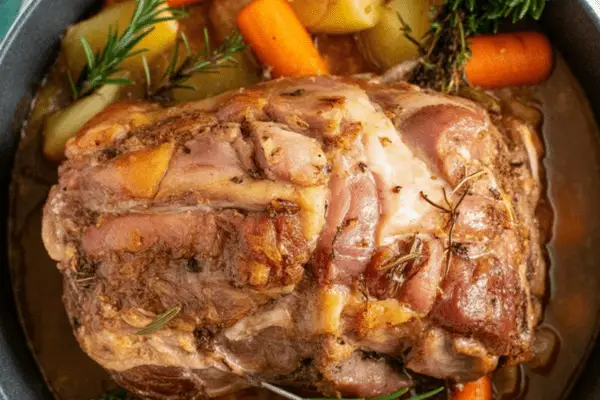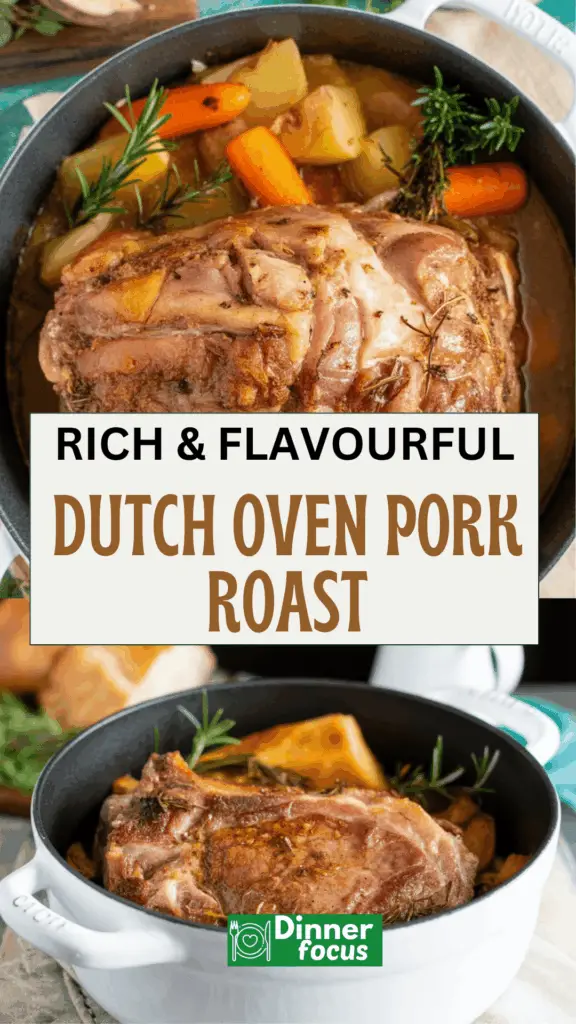Tender, juicy, and loaded with flavor, this Dutch oven pork roast is one of those meals that just feels like home. When the weather turns cool or I want something that really sticks to the ribs, I’ll make this. The pork bakes slowly in apple cider broth with herbs, potatoes, and vegetables—then I finish it with a simple, rich gravy. It’s the kind of dinner that gets everyone lingering at the table for second helpings.

The Best Cut of Meat for a Pork Roast Recipe
People often ask me what cut I use, and the truth is you have options. Pork shoulder (Boston butt) is great if you want something a bit fattier and don’t mind the longer cook time—it’s perfect for when you have all afternoon.
But I usually go for a boneless pork loin roast. It’s leaner, smaller, and cooks faster while staying tender if you do it right. It’s the cut I use when I want to get a hearty dinner on the table in under two hours without babysitting the oven all day.
I’d steer clear of pork tenderloin here. It’s too lean and better for high-heat, quick cooking—it’ll dry out in the Dutch oven if you try to braise it this way.
Why Use a Dutch Oven
I know some folks swear by their slow cooker or Instant Pot, but for me nothing beats the Dutch oven for this kind of roast.
That thick cast iron retains heat like a champ and distributes it evenly, so you don’t get hot spots or overcooked bits. And the tight-fitting lid seals in moisture, which is the real secret to keeping the pork juicy.
When I use a Dutch oven, I don’t have to worry about coming back to find the meat dried out. Plus, you can control the cooking time more precisely than with a slow cooker—especially for the potatoes, which I hate when they get mushy.

How to Cook a Dutch Oven Pork Roast
Here’s how I do it most weekends:
- Dredge and sear: I season the pork with flour, salt, and pepper. That light flour coating helps thicken the gravy later. I always sear the meat until it’s nicely browned on all sides—don’t rush this. That crust gives so much flavor.
- Deglaze and sauté: After removing the pork, I splash in broth to loosen all those brown bits at the bottom. Then I toss in onions, carrots, celery—whatever I have on hand. Letting them sauté a few minutes builds the base of the sauce.
- Assemble: I nestle the pork back in, pour over the broth and apple cider (this gives it a subtle sweetness without being cloying), and tuck in some bay leaves and herbs.
- Bake: I cover and bake it at 350°F. About 40 minutes before it’s done, I add peeled potatoes. This keeps them tender but not falling apart.
- Rest: When it’s done, I always let the pork rest for 10-15 minutes. This step is easy to skip, but don’t—it helps the juices redistribute so it stays moist when sliced.
- Gravy: While it rests, I whisk butter and flour into the strained pan drippings. This gravy is pure comfort—no packet mix needed.
This method lets the pork stay juicy, the potatoes cook to the perfect texture, and the vegetables soak up all that apple-cider richness.

How Long to Cook a Pork Roast
I usually aim for about 20 minutes per pound at 350°F. For a 4-pound roast, that’s roughly 1 hour and 20 minutes. But here’s my trick: I always start checking around the 70-minute mark.
Dutch ovens are efficient—they really hold heat—so sometimes things cook faster than you expect.
The best insurance is a meat thermometer. I pull the roast when it hits about 140°F in the center, knowing it’ll carry over to the safe 145°F while it rests. No one likes dry pork roast, and this trick helps avoid that.
Serving Suggestions
This is the kind of dinner that calls for something cozy on the side. I usually serve it with buttery mashed potatoes if I’m not cooking them in the pot. Or flaky biscuits to mop up that gravy.
On special occasions, I might bake a casserole of spinach or make old-school creamed peas like my grandmother used to. Even a simple green salad with candied nuts feels like the right touch.
And if there’s leftover gravy? It goes over everything the next day. I’ve even spooned it onto open-faced sandwiches with the leftover pork.
Preparation and Storage Tips
If you’re cooking for a smaller household, don’t worry about leftovers—they’re fantastic. I store them in an airtight container in the fridge for about 3-4 days.
Sometimes I’ll freeze slices for later. Wrapped well, they keep for up to 3 months.
For reheating, I like popping them back in the oven at 325°F until they’re warmed through. You can also microwave smaller portions, though I do that carefully so they don’t dry out.
Leftover pork makes amazing sandwiches the next day. I’ll pile slices onto buns with barbecue sauce or leftover gravy. It’s one of those meals that’s just as good, if not better, the next day.
Dutch Oven Pork Roast

There’s something deeply comforting about the aroma of a slow-roasted pork loin filling the house on a chilly afternoon.
Ingredients
- ⅓ cup all-purpose flour – for dredging the roast to get that gorgeous golden crust
- Kosher salt and black pepper – don’t be shy, season generously
- 4 lb. boneless pork loin roast – the star of the show
- 1 tbsp butter + 2 tbsp olive oil – for searing
- 2 cups chicken broth, divided – adds depth and keeps everything juicy
- 5 carrots, peeled and cut into hearty chunks
- 2 onions, thinly sliced
- 4 celery ribs, chopped into crescents
- 2 garlic cloves, minced
- 1 cup apple cider – adds a subtle sweetness (not vinegar!)
- Fresh herbs: 4 sprigs each of thyme and rosemary, plus 2 bay leaves
- 3 russet potatoes, peeled and cut into eighths
Optional Gravy:
- 2 tbsp butter
- 2 tbsp flour
- 1 – 1½ cups of the pork drippings from the pot
Instructions
- Prep & SearStart by preheating your oven to 350°F. On a plate or a piece of waxed paper, mix the flour with a generous pinch of salt and pepper. Pat your pork roast dry (this helps it brown properly) and coat it in the seasoned flour.
- In your Dutch oven, heat the butter and oil over medium-high heat. Once hot, sear the pork on all sides until it develops a deep, golden crust—about 4 to 6 minutes per side. Don’t worry about cooking it through; it’ll finish in the oven. Transfer the seared pork to a plate and set aside.
- Build the Flavor BaseLower the heat to medium and pour in 1 cup of chicken broth. Use a wooden spoon to scrape up all those rich browned bits from the bottom of the pot—this is liquid gold for flavor.
- Toss in the carrots, onions, celery, and garlic. Sauté for about 10 minutes, just until the onions turn translucent and the vegetables start to soften.
- Roast Low & SlowNestle the pork back into the pot, right on top of the veggies. Pour in the remaining broth and the apple cider. Tuck in the herbs and bay leaves. Add a final sprinkle of salt and pepper, then cover and transfer to the oven.
- Let it roast for about 70–80 minutes total, depending on the size of your pork (roughly 20 minutes per pound). When there’s about 40–45 minutes left on the clock, stir in the potatoes so they can soak up all the flavorful juices and roast until tender.
- Step 4: Rest & SliceOnce the pork hits an internal temperature of 145°F and the potatoes are fork-tender, pull it from the oven and let it rest for 10–15 minutes. This step is key—it lets the juices redistribute for the most tender slices.
- Optional: Make a Silky Gravy
- If you're a gravy lover (aren’t we all?), don’t skip this step. Strain the pan drippings and set them aside. In a skillet, melt 2 tablespoons of butter over medium heat, then whisk in 2 tablespoons of flour. Let it cook for about 30 seconds, then slowly pour in the drippings while whisking constantly. Keep stirring as it bubbles and thickens—season with salt and pepper to taste.
Notes
- Cooking times may vary depending on the exact weight and temperature of your roast when it goes into the oven. Use a meat thermometer for best results.
- If you prefer a thicker gravy, you can reduce the liquid a bit more or increase the flour slightly during the roux stage.
- This dish makes excellent leftovers—the flavors only get better overnight!
Nutrition Information
Yield
6Serving Size
1Amount Per Serving Calories 1000Total Fat 46gSaturated Fat 16gTrans Fat 1gUnsaturated Fat 24gCholesterol 311mgSodium 657mgCarbohydrates 41gFiber 5gSugar 9gProtein 100g
Dinnerfocus.com, occasionally offers nutritional information for recipes contained on this site. This information is provided as a courtesy and is an estimate only. This information comes from online calculators. Although allchickenrecipes.com attempts to provide accurate nutritional information, these figures are only estimates.
Tips for the Best Pork Roast Recipe
- Always cook it covered in the Dutch oven to lock in moisture. That lid is your friend.
- Check early. Dutch ovens cook efficiently and sometimes faster than you expect.
- Use a thermometer. Don’t guess. It saves you from dry meat.
- Let it rest. This simple step keeps the juices in the roast instead of running all over the cutting board.
I hope you’ll give this Dutch oven pork roast a try. It’s the kind of meal that makes the whole house smell welcoming and turns any evening into a special one—even if it’s just an ordinary Sunday.
Try other recipes:
